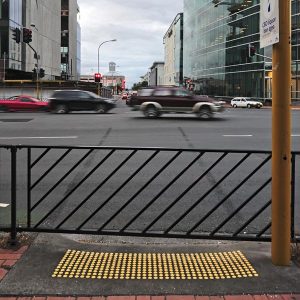 On 2 June 2015 Robert Su, 33 was heading home from work at the ASB bank to his family in Hillcrest. Like hundreds of commuters he was walking from Wynyard Quarter to the bus stops on Fanshawe Street. Tragically while crossing the road he was struck by a truck and killed. The exact details of the crash have not been released but it is highly likely that a range of factors were involved – speed, driver error, vehicle design, road design, weather conditions. Flowers have been placed in memory of Mr Su at the pedestrian crossing.
On 2 June 2015 Robert Su, 33 was heading home from work at the ASB bank to his family in Hillcrest. Like hundreds of commuters he was walking from Wynyard Quarter to the bus stops on Fanshawe Street. Tragically while crossing the road he was struck by a truck and killed. The exact details of the crash have not been released but it is highly likely that a range of factors were involved – speed, driver error, vehicle design, road design, weather conditions. Flowers have been placed in memory of Mr Su at the pedestrian crossing.
The day after Mr Su’s death a woman was killed in Orewa as she crossed the road marking a week when two pedestrians were also seriously injured and a rider on his way to work was almost killed. So far this year 14 pedestrians have been killed in NZ, 4 in the Auckland area.

What I find particularly tragic and frustrating about Mr Su’s death is that the road he was expected to cross is designed like a motorway for speed and traffic efficiency. For drivers coming off SH1 there are no clues that Fanshawe St is the gateway to the central city. For some time office blocks have been going up near by but no changes have been made to the road to respond to changing land use and the growing numbers of people walking (and cycling) through the area.
At a time when the Auckland Council family of organisations is working to make the city the most liveable in the world through a whole range of transformational projects we continue to let down our most vulnerable road users. Improvements are definitely underway (eg removal of slip lanes in the city centre, complete street upgrades) and various campaigns take a safe systems approach to road safety supported by the NZ Police but what I think is missing is a comprehensive, everyone on board, Vision Zero response where we, collectively as a city, do not consider any fatalities or serious injuries are acceptable or inevitable.

I think Auckland needs to officially adopt Vision Zero (as the Mayor of NYC did in January 2014 ) with a clear action plan. It will need support from politicians, traffic engineers, transport agencies, all road users and grassroots campaigners. Most importantly it will require a huge culture shift in our attitudes to driving and acceptance that managing speeds is at the heart of improving safety.
There is strong community support for improving public transport and providing greater opportunities for active travel (as indicated by feedback on the Auckland Council’s Long Term Plan) but too often resistance if this means slowing down drivers. It is far too common to hear complaints that speed enforcement is “revenue raising” and politicians shy away from taking decisive action on speed control in the face of evidence and the recommendation of safety experts.
Vision Zero AKL – embracing street design, slower speeds, rules changes, education and enforcement -I think could provide the right platform for far greater public support for the concept of putting the safety of people first.
In the meantime I think there is the need for immediate action focused on city centre streets so that no one needs to be put at risk of getting killed on their way home from work.

- Remove motorway signage from Fanshawe St
- Install the missing pedestrian crossing at the intersection of Fanshawe St and Halsey St (this needs to happen before the new Fonterra HQ opens)
- Enforce the speed limit particularly on “motorway” style city streets like Fanshawe, Hobson and Nelson
- Implement the 30km/h speed limit for the City Centre and Wynyard Quarter (as proposed in the City Centre masterplan)
- Repair the urban fabric of the city where footpaths connections are missing
- Target road safety campaigns
(this is my initial list as a non expert – I am sure there are many more actions requiring immediate attention)
Update 17 July 2016
I’ve joined the call to for Vision Zero to be adopted for NZ to bring down road toll
More reading
Five key lessons from Europe’s Vision Zero Success
1) Managing speeds — and speed differentials — is a top priority
In all three of these countries, the leaders of traffic safety efforts emphasize that managing speed is the number one determinant in their successes in improving safety.
Over the past 15 years, the national governments of Sweden, the Netherlands, and Germany have all proactively and systematically changed their approaches to speed. Each nation (to differing degrees, but all significantly) has lowered speed limits for a clearly defined hierarchy of roads and corresponding speeds. For instance, the Netherlands has shifted…
- from 50 kilometers per hour (kph) to 30 kph on smaller, residential streets;
- from 70 kph to 50 kph on bigger, or what we’d consider arterial roads; and
- from 100 kph to 70 kph on the freeway-like roads outside cities.
In each of the three nations, nearly everyone I’ve spoken with credits speed management as the greatest contributor to their success in improving safety on the streets and saving more lives.


Thank you Pippa for highlighting these problems. We can make Auckland better